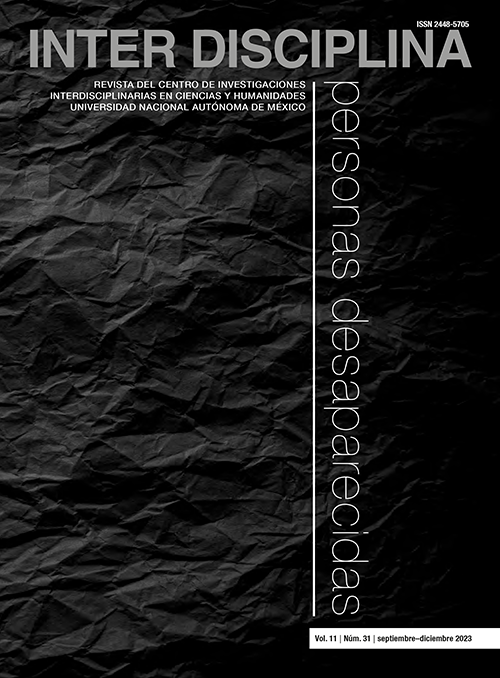Thelma & Louise y Viaje redondo: el viaje de la heroína y la fluidez del género
Contenido principal del artículo
Resumen
Este artículo compara y valora dos road movies desde una perspectiva de género sin descuidar el tema de la interseccionalidad, con un acercamiento a la estructura narrativa de ambas películas, para destacar en estas "el camino de la heroína" como itinerario contrapuesto al tradicional "camino del héroe". Este recorrido permite enfatizar el tema del gender al tiempo que subraya algunos aspectos míticos de la ruta heroica.
Descargas
Detalles del artículo
Citas en Dimensions Service
Citas
Balogh, Anna Maria. 2010. La representación de heroínas en el tiempo narrado y en el espacio construido del cine. Significação: revista de cultura audiovisual, 37(34): 123-139. https://doi.org/10.11606/issn.2316-7114.sig.2010.68117.
Butler, Judith. 2007. El género en disputa. El feminismo y la subversión de la identidad. Barcelona: Paidós.
Campbell, Joseph. 1972. El héroe de las mil caras. México: FCE.
Campbell, Joseph. 2004. The hero with a thousand faces. Princeton: Universidad de Princeton.
Cohan, Steven e Ina Rae Hark. 1997. The road movie book. Londres: Routledge.
Cooper, Brenda. 2000. ‘Chick Flicks’ as feminist texts: The appropriation of the male gaze in Thelma & Louise. Women’s Studies in Communication, 23(3): 277-306. https://doi.org/10.1080/07491409.2000.11735771.
Cosentino, Olivia. 2016. Configuring desire and social order in the contemporary mexican youth road film. En Verónica Garibotto y Jorge Pérez (eds.), The Latin American road movie. Nueva York: Palgrave Macmillan, 195-215.
Derrida, Jacques. 1980. The law of genre. Critical Inquiry, 7(1): 55-81.
Enevold, Jessica. 2004. The daughters of Thelma and Louise: New? Aesthetics of the road. En Kristi Siegel (ed.), Gender, genre, and identity in women’s travel writing. Nueva York: Peter Lang, 73-95.
Ericsson, Stina. 2021. Gender and sexuality normativities: using conversation analysis to investigate heteronormativity and cisnormativity in interaction. En Jo Angouri y Judith Baxter (eds.), The routledge handbook of language, gender, and sexuality. Nueva York: Routledge, 289-298.
Estelle Frankel, Valerie. 2010. From girl to goddess: The heroine’s journey through myth and legend. Carolina del Norte: McFarland.
Kapila, Gitanjali. 2021. Atascada en un laberinto (o en una torre) con el minotauro y tratando de escapar: la princesa Aurora y la emperadora Furiosa son las heroínas del mito múltiple. 91 del Centro de Estudios en Diseño y Comunicación [Ensayos], 91: 13-20. https://dialnet.unirioja.es/servlet/articulo?codigo=7303525.
Harvey R. Greenberg, Carol J. Clover et. al. 1991. The many faces of Thelma & Louise. Film Quarterly, 45(2): 20-31, diciembre 1. https://doi.org/10.2307/1213075.
Heller-Nicholas, Alexandra. 2012. The F word: power and gender in Thelma and Louise. Screen Education, 66: 105-110.
Hill Collins, Patricia y Sirma Bilge. 2019. Interseccionalidad. Madrid: Morata.
Indurain Eraso, Carmen. 2001. Thelma and Louise: Easy riders in a male genre. Atlantis, 23(1): 63-73.
Kemp, Sandra y Judith Squires. 1997. Feminisms. Nueva York: Oxford University Press.
Kinder, Marsha. 1991. Thelma & Louise and Messidor as feminist road movies. Film Quarterly, 45(2): 30-31.
Man, Glenn. 1993. Gender, genre, and myth in Thelma and Louise. Film Criticism, 18(1): 36-53. http://www.jstor.org/stable/44075990.
Murdock, Maureen. 1990. The heroine’s journey: woman’s quest for wholeness. Colorado: Shamballa.
Pontoriero, Andrea. 2020. Mujer y cine, ¿hay lugar para la heroína? Cuadernos del Centro de Estudios en Diseño y Comunicación [Ensayos], 117: 73-83. https://dialnet.unirioja.es/servlet/articulo?codigo=8304452.
Roberts, Shari. 1997. Western meets eastwood. Genre and gender on the road. En Steven Cohan e Ina Rae Hark (eds.), The road movie book. Londres: Routledge, 45-69.
Shapiro, Brooke. 2017. Examining portrayals of female protagonists by female screenwriters using feminist critical discourse analysis. The Young Researcher, 1(1): 37-47. http://www.theyoungresearcher.com/papers/shapiro.pdf
Tatar, Maria. 2021. The heroine with 1001 faces. Nueva York: W. W. Norton.
Filmografía
Hopper, Dennis (dir.). 1991. Easy rider. Estados Unidos.
Scott, Ridley (dir.). 1991. Thelma and Louise. Estados Unidos.
Tort, Gerardo (dir.). 2009. Viaje redondo. México.
Página web
The Heroine Journey’s Project. https://heroinejourneys.com/.

Esta obra está bajo una Licencia Creative Commons Atribución-NoComercial-SinDerivar 4.0 Internacional.





